mobility
- Related Topics:
- electrical conduction
mobility, in solid-state physics, measurement of the ease with which a particular type of charged particle moves through a solid material under the influence of an electric field. Such particles are both pulled along by the electric field and periodically collide with atoms of the solid. This combination of electric field and collisions causes the particles to move with an average velocity, called the drift velocity. The charge carrier in most metals is the negatively charged electron (see electron scattering).
Mobility is formally defined as the value of the drift velocity per unit of electric field strength; thus, the faster the particle moves at a given electric field strength, the larger the mobility. The mobility of a particular type of particle in a given solid may vary with temperature.
Mobility also depends on the type of solid. For example, in semiconductors, electric current is also carried by the motion of positively charged particles called holes, each of which corresponds to the absence of an electron, a condition that complicates the determination of their separate mobilities. Many electronic devices require high mobilities for efficient operation. See also quantum electrodynamics.













